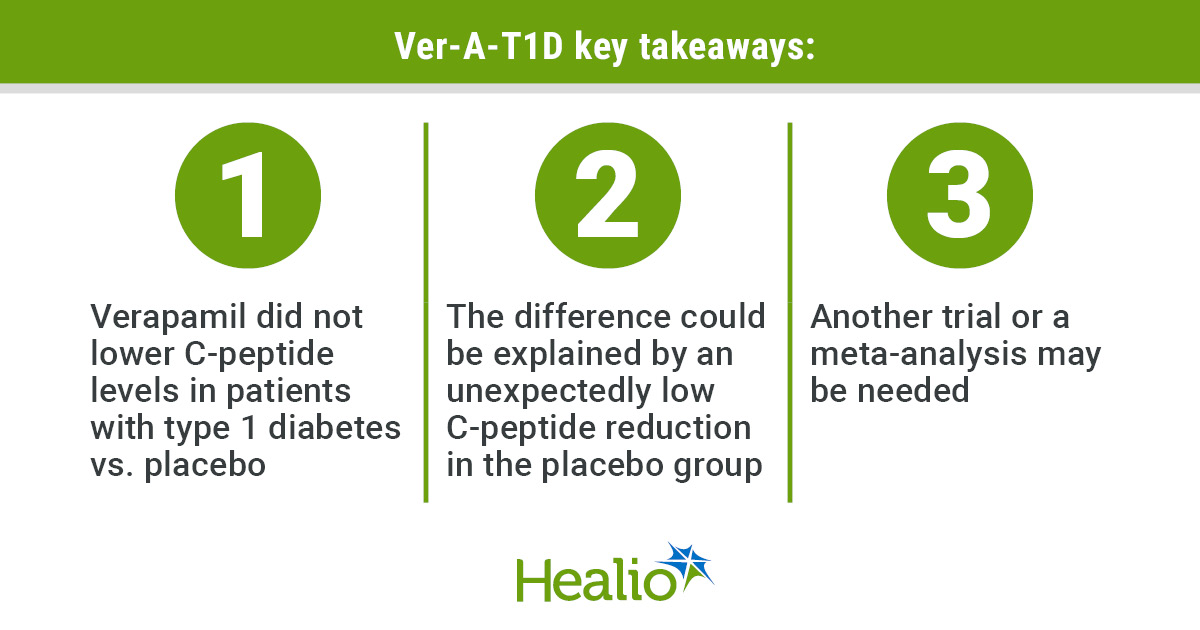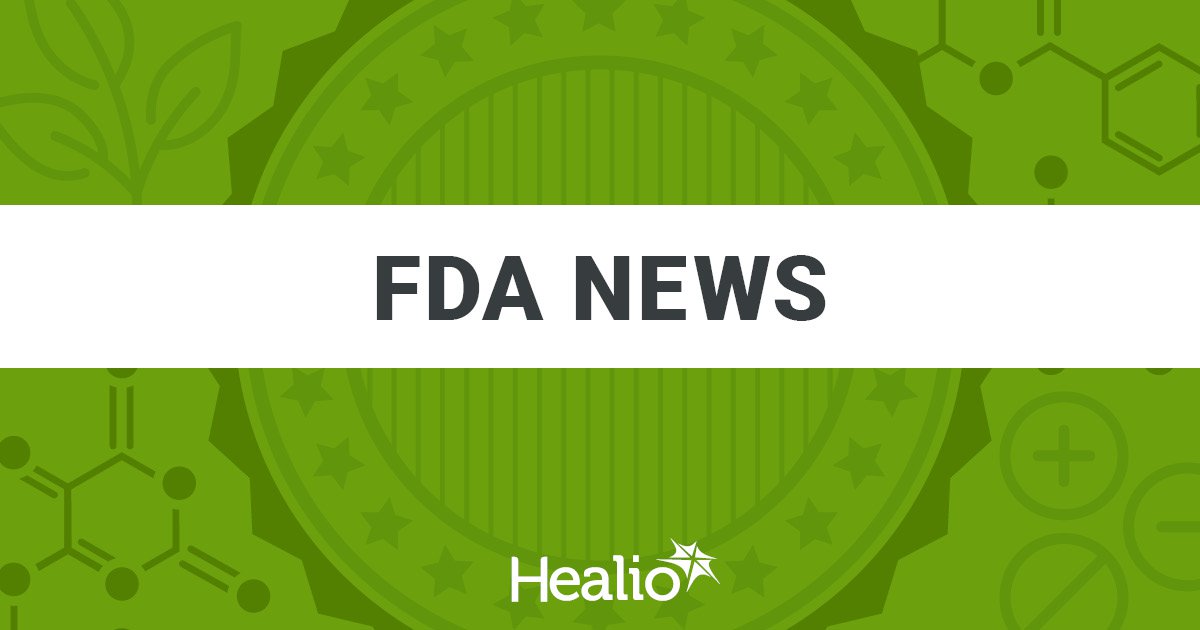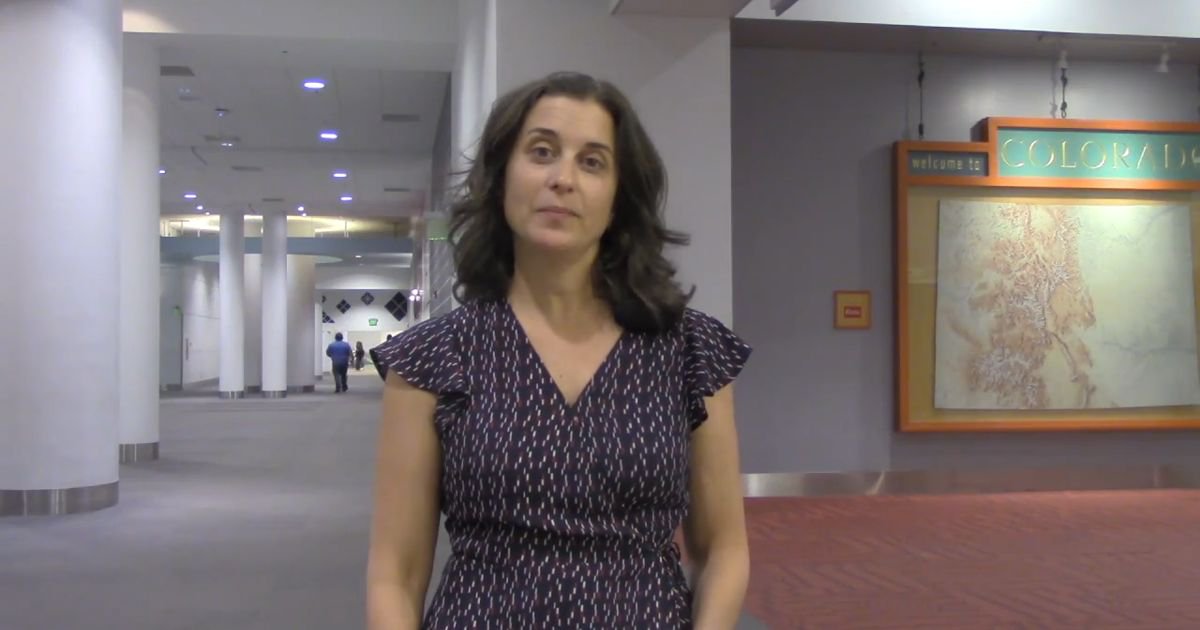September 25, 2025
3 min read
Key takeaways:
- Adults with new-onset type 1 diabetes receiving verapamil did not have a significantly higher C-peptide at 1 year than placebo.
- The placebo group had a lower than predicted C-peptide deterioration in the trial.
Once-daily verapamil did not significantly improve C-peptide levels compared with placebo for adults with new-onset type 1 diabetes, according to findings from a randomized controlled trial.
An unexpectedly low drop in C-peptide levels in the placebo group may have made the trial underpowered to show an effect of verapamil on C-peptide levels, according to the researchers.

Infographic content were derived from Pieber T. S36a. Presented at: European Association for the Study of Diabetes Annual Meeting; Sept. 15-19, 2025; Vienna.
As Healio previously reported, once-daily oral verapamil led to higher C-peptide concentrations at 1 year than placebo among children and adolescents with type 1 diabetes. In a presentation at the European Association for the Study of Diabetes annual meeting, researchers unveiled data from the Ver-A-T1D trial, which compared once-daily verapamil sustained release with placebo among adults recently diagnosed with stage 3 type 1 diabetes.
“Verapamil is known as a drug that [health care professionals] gave in hypertension and some arrythmias in the past,” Thomas R. Pieber, MD, professor of medicine and chair of the division of endocrinology and diabetology in the department of internal medicine at Medical University of Graz in Austria, said in a press conference. “But verapamil, we have learned over the years, also has an effect on beta cells. It regulates a very important pathway that has to do with beta-cell stress. We believe that beta-cell stress has to do with the occurrence of type 1 [diabetes].”
Researchers enrolled 136 adults aged 18 years and older with new-onset type 1 diabetes to participate in the trial (mean age, 29 years; 68% men). Participants were recruited from 21 sites in six European countries. Adults were randomly assigned 2:1 to once-daily 360 mg verapamil or placebo for 1 year. The primary outcome was area under the curve C-peptide as measured through a 2-hour mixed-meal tolerance test.
Trial outcomes
In the intention-to-treat analysis, researchers observed no significant difference in C-peptide levels between the verapamil and placebo groups at 1 year. There was also no difference seen between the groups at 3, 6 and 9 months.
Pieber said the lack of significant improvement in C-peptide with verapamil may have been due to the C-peptide trajectory in the placebo group. The verapamil group had a very slight increase in AUC C-peptide from 0.863 nmol/L/min at baseline to 0.868 nmol/L/min at 1 year. The placebo group’s AUC C-peptide dropped from 0.841 nmol/L/min at baseline to 0.753 nmol/L/min at 1 year.
“The placebo group was doing much better than expected,” Pieber said. “We predicted a drop of 20% in C-peptide and on this occasion, the C-peptide only dropped from 0.84 to 0.75, which is roughly 10%. This was unexpected.
“Because we assumed a larger drop in C-peptide in the control group, in turns out in retrospect that this trial was underpowered to see a significant difference in the verapamil treatment,” Pieber later added.
In per-protocol analysis, which excluded 13 adults who withdrew from the study and seven participants who discontinued treatment, the verapamil group had a greater improvement in C-peptide than the placebo group (mean difference, 0.062 nmol/L/min; 95% CI, 0.005-0.119; P = .034).
The verapamil group had a lower HbA1c level than the placebo group at 1, 2, 3 and 6 months. HbA1c did not differ between the groups at 9 months and 1 year. No difference was observed in total daily insulin dose at any time point. Continuous glucose monitoring metrics were similar between the two groups during the study.
Safety data
The proportion of participants who experience serious adverse events was higher in the placebo group than the verapamil group (11% vs. 7%). Two grade 4 adverse events occurred with verapamil, one suicide attempt and one case of severe hypoglycemia.
Cardiac disorders were more common among verapamil participants than adults in the placebo group (46% vs. 20%).
“First-degree atrioventricular block was the most common verapamil side effect, it was usually mild and reversible upon dose reduction,” Pieber said during the session.
Pieber said more research is needed to further assess verapamil in adults. He said researchers plan to analyze AUC C-peptide at 2 years in the Ver-A-T1D trial to see if C-peptide trajectory changes for the placebo group. Additionally, an open-label extension is planned to assess C-peptide levels with verapamil more than 3 years after treatment initiation.
Pieber also suggested conducting a meta-analysis of randomized controlled trials and performing another trial similar to Ver-A-T1D with a longer follow-up and larger study population.










